Gravitation;
- Books Name
- Science Made Easy Science Book
- Publication
- Science Made Easy
- Course
- CBSE Class 9
- Subject
- Science
Introduction
→ Gravitational Force of Earth: If we release a small stone without pushing it from a height, it accelerates towards earth. Earth attracts everything towards it by an unseen force of attraction. This force of attraction is known as gravitation or gravitational pull
universal law of gravitation
- Books Name
- Science Made Easy Science Book
- Publication
- Science Made Easy
- Course
- CBSE Class 9
- Subject
- Science
Universal Law of Gravitation
→ Sir Isaac Newton in 1687 proposed a law about the force of attraction between the
objects in the universe which is known as Newton’s law of gravitation.
According to Universal law of Gravitation
→ Every mass in this universe attracts every other mass with a force which is directly proportional to
the product of two masses and inversely proportional to the square of the distance between them
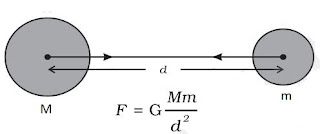
• Let masses (M) and (m) of two objects are distance (d) apart, then force of attraction (F) between
them
F ∝ M×m
F ∝ 1/d2
F ∝ Mm/d2
F = (GMm)/d2
where,
G is a constant and is known as Gravitational constant.
Value of G = 6.67×10-11 Nm2/kg2
G is called universal gravitational constant.
→ If unit of F is in Newton, m is in kg, d is in mere, then unit of G can be calculated as :
G = (F×d2)/Mm, therefor unit will be Nm2/kg2
Importance of universal law of gravitation
(i) The force that binds us to the earth.
(ii) The motion of moon around the earth.
(iii) The motion of earth around the sun.
(iv) The tides due to moon and the sun.
force of gravitation of the earth (gravity)
- Books Name
- Science Made Easy Science Book
- Publication
- Science Made Easy
- Course
- CBSE Class 9
- Subject
- Science
Free fall of an object and acceleration (g)
→ When an object is thrown upward, it reaches certain height, then it starts falling down towar
earth. It is because the earth’s gravitational force exerts on it.
→ This fall under the influence of earth is called ‘free fall of an object’.
→ During this free fall direction do not change but velocity continuously changes which is calle
acceleration due to gravity. It is denoted by ‘g’.
→ Its unit is same as acceleration m/s .
acceleration due to gravity
- Books Name
- Science Made Easy Science Book
- Publication
- Science Made Easy
- Course
- CBSE Class 9
- Subject
- Science
Gravitational Acceleration and its value at the surface of earth
→ The uniform acceleration produced in a freely falling object due to the gravitational force of
earth, is called acceleration due to gravity.
→ It is represented by ‘g’ and it always acts towards the centre of the earth.
Mathematical Expression for g
From the second law of motion, force is the product of mass and acceleration.
F = ma
For free fall, acceleration is replaced by acceleration due to gravity.
Therefore, force becomes:
F = mg ….(i)
But from Universal Law of Gravitation,
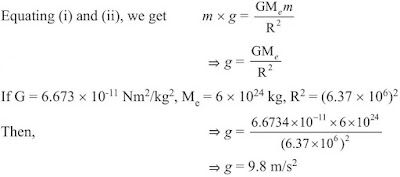
Factors Affecting the Value of g
- As the radius of the earth increases from the poles to the equator, the value of g becomes greater at the poles than at the equator.
- As we go at large heights, value of g decreases.
To Calculate the Value of g
Value of universal gravitational constant, G = 6.7 × 10–11 N m2/ kg2,
Mass of the earth, M = 6 × 1024 kg, and
Radius of the earth, R = 6.4 × 106 m
Putting all these values in equation (iii), we get:
![]()
Thus, the value of acceleration due to gravity of the earth, g = 9.8 m/s2.
Difference between Gravitation Constant (G) and Gravitational Acceleration (g)
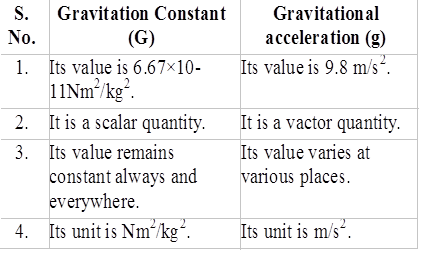
Motion of Objects Under the Influence of Gravitational Force of the Earth
Let an object is falling towards earth with initial velocity u. Let its velocity, under the effect of gravitational acceleration g, changes to v after covering the height h in time t.
Then the three equations of motion can be represented as:
Velocity (v) after t seconds, v = u + ght
Height covered in t seconds, h = ut + ½gt2
Relation between v and u excluding t, v2 = u2 + 2gh
The value of g is taken as positive in case of the object is moving towards earth and taken as negative in case of the object is thrown in opposite direction of the earth.
mass and weight
- Books Name
- Science Made Easy Science Book
- Publication
- Science Made Easy
- Course
- CBSE Class 9
- Subject
- Science
Mass & weight
Mass (m)
- The mass of a body is the quantity of matter contained in it.
- Mass is a scalar quantity which has only magnitude but no direction.
- Mass of a body always remains constant and does not change from place to place.
- SI unit of mass is kilogram (kg).
- Mass of a body can never be zero.
Weight (W)
- The force with which an object is attracted towards the centre of the earth, is called the weight of the object.
Now, Force =m×a
But in case of earth,a=g
∴F=m×g
But the force of attraction of earth on an object is called its weight (W).
∴W=mg - As weight always acts vertically downwards, therefore, weight has both magnitude and direction and thus it is a vector quantity.
- The weight of a body changes from place to place, depending on mass of object.
- The SI unit of weight is Newton.
- Weight of the object becomes zero if g is zero.
Weight of an Object on the Surface of Moon
Mass of an object is same on earth as well as on moon. But weight is different.
weight of the object on the moon = (1/6) × its weight on the earth.
free fall
- Books Name
- Science Made Easy Science Book
- Publication
- Science Made Easy
- Course
- CBSE Class 9
- Subject
- Science
Free fall of an object and acceleration (g)
→ When an object is thrown upward, it reaches certain height, then it starts falling down towar
earth. It is because the earth’s gravitational force exerts on it.
→ This fall under the influence of earth is called ‘free fall of an object’.
→ During this free fall direction do not change but velocity continuously changes which is calle
acceleration due to gravity. It is denoted by ‘g’.
→ Its unit is same as acceleration m/s .
1. Introduction
- Books Name
- Science Made Easy Science Book
- Publication
- Science Made Easy
- Course
- CBSE Class 9
- Subject
- Science
Introduction
→ Gravitational Force of Earth: If we release a small stone without pushing it from a height, it
accelerates towards earth. Earth attracts everything towards it by an unseen force of attraction. This force of attraction is known as gravitation or gravitational pull
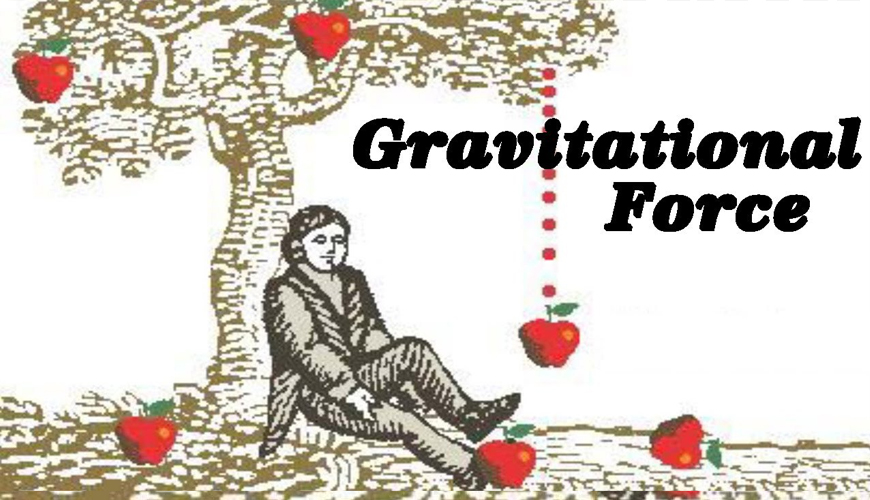
Universal Law of Gravitation
→ Sir Isaac Newton in 1687 proposed a law about the force of attraction between the
objects in the universe which is known as Newton’s law of gravitation.
According to Universal law of Gravitation
→ Every mass in this universe attracts every other mass with a force which is directly proportional to
the product of two masses and inversely proportional to the square of the distance between them
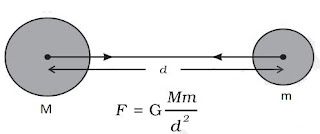
• Let masses (M) and (m) of two objects are distance (d) apart, then force of attraction (F) between
them
F ∝ M×m
F ∝ 1/d2
F ∝ Mm/d2
F = (GMm)/d2
where,
G is a constant and is known as Gravitational constant.
Value of G = 6.67×10-11 Nm2/kg2
G is called universal gravitational constant.
→ If unit of F is in Newton, m is in kg, d is in mere, then unit of G can be calculated as :
G = (F×d2)/Mm, therefor unit will be Nm2/kg2
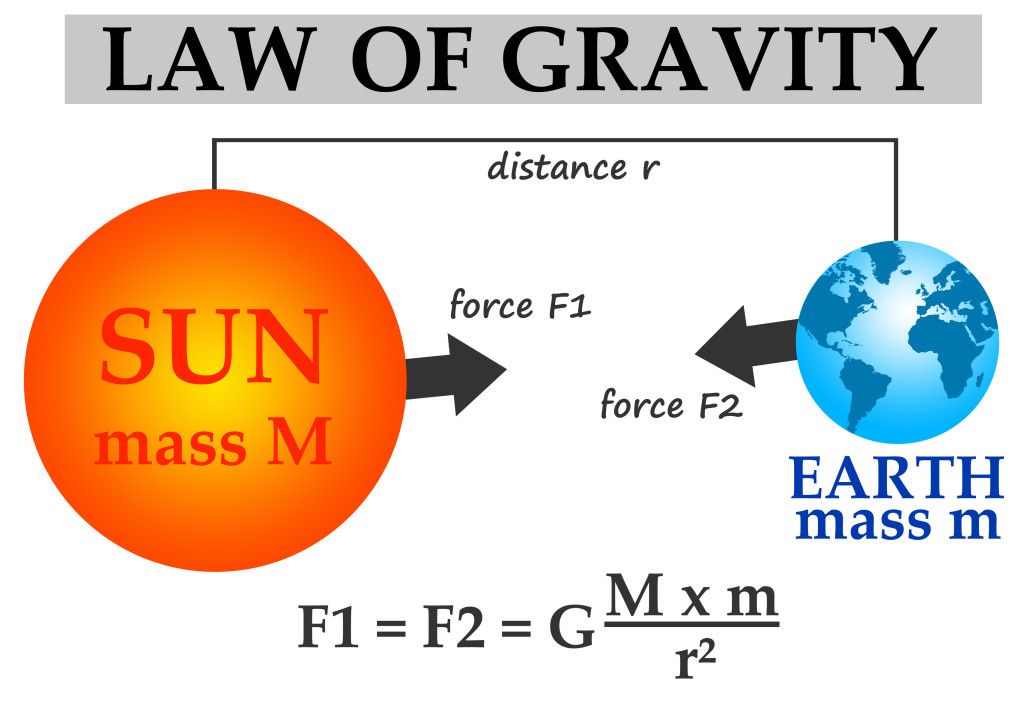
Importance of universal law of gravitation
(i) The force that binds us to the earth.
(ii) The motion of moon around the earth.
(iii) The motion of earth around the sun.
(iv) The tides due to moon and the sun.
2. Gravitational Constant and its Units
- Books Name
- Science Made Easy Science Book
- Publication
- Science Made Easy
- Course
- CBSE Class 9
- Subject
- Science
Free fall of an object and acceleration (g)
→ When an object is thrown upward, it reaches certain height, then it starts falling down towar
earth. It is because the earth’s gravitational force exerts on it.
→ This fall under the influence of earth is called ‘free fall of an object’.

→ During this free fall direction do not change but velocity continuously changes which is calle
acceleration due to gravity. It is denoted by ‘g’.
→ Its unit is same as acceleration m/s .
3. Weight and Mass
- Books Name
- Science Made Easy Science Book
- Publication
- Science Made Easy
- Course
- CBSE Class 9
- Subject
- Science
Gravitational Acceleration and its value at the surface of earth
→ The uniform acceleration produced in a freely falling object due to the gravitational force of
earth, is called acceleration due to gravity.
→ It is represented by ‘g’ and it always acts towards the centre of the earth.
Mathematical Expression for g
From the second law of motion, force is the product of mass and acceleration.
F = ma
For free fall, acceleration is replaced by acceleration due to gravity.
Therefore, force becomes:
F = mg ….(i)
But from Universal Law of Gravitation,
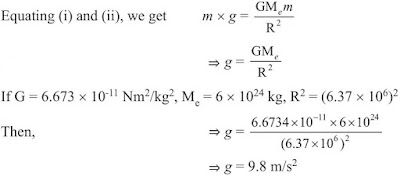
Factors Affecting the Value of g
- As the radius of the earth increases from the poles to the equator, the value of g becomes greater at the poles than at the equator.
- As we go at large heights, value of g decreases.
To Calculate the Value of g
Value of universal gravitational constant, G = 6.7 × 10–11 N m2/ kg2,
Mass of the earth, M = 6 × 1024 kg, and
Radius of the earth, R = 6.4 × 106 m
Putting all these values in equation (iii), we get:

Thus, the value of acceleration due to gravity of the earth, g = 9.8 m/s2.
4. Buoyancy and Density
- Books Name
- Science Made Easy Science Book
- Publication
- Science Made Easy
- Course
- CBSE Class 9
- Subject
- Science
Difference between Gravitation Constant (G) and Gravitational Acceleration (g)
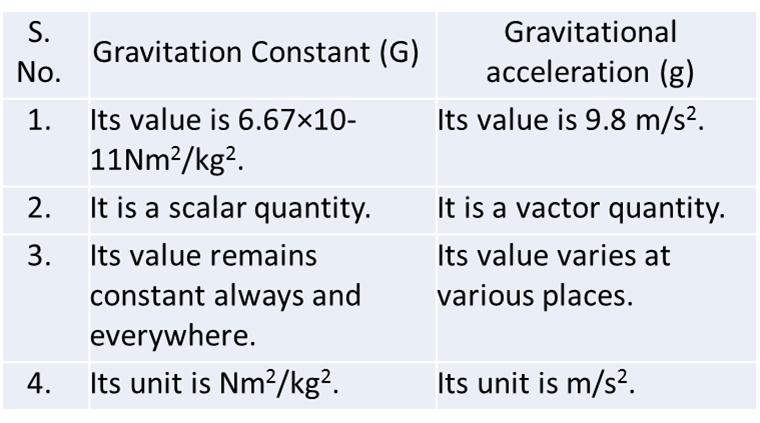
Motion of Objects Under the Influence of Gravitational Force of the Earth
Let an object is falling towards earth with initial velocity u. Let its velocity, under the effect of gravitational acceleration g, changes to v after covering the height h in time t.
Then the three equations of motion can be represented as:
Velocity (v) after t seconds, v = u + ght
Height covered in t seconds, h = ut + ½gt2
Relation between v and u excluding t, v2 = u2 + 2gh
The value of g is taken as positive in case of the object is moving towards earth and taken as negative in case of the object is thrown in opposite direction of the earth.
MOTION OF OBJECT UNDER GRAVITY
- Books Name
- Science Made Easy Science Book
- Publication
- Science Made Easy
- Course
- CBSE Class 9
- Subject
- Science
Motion of Objects Under the Influence of Gravitational Force of the Earth
Let an object is falling towards earth with initial velocity u. Let its velocity, under the effect of gravitational acceleration g, changes to v after covering the height h in time t.
Then the three equations of motion can be represented as:
Velocity (v) after t seconds, v = u + ght
Height covered in t seconds, h = ut + ½gt2
Relation between v and u excluding t, v2 = u2 + 2gh
The value of g is taken as positive in case of the object is moving towards earth and taken as negative in case of the object is thrown in opposite direction of the earth.
5. Archimedes'S Principle
- Books Name
- Science Made Easy Science Book
- Publication
- Science Made Easy
- Course
- CBSE Class 9
- Subject
- Science
Mass & weight
Mass (m)
- The mass of a body is the quantity of matter contained in it.
- Mass is a scalar quantity which has only magnitude but no direction.
- Mass of a body always remains constant and does not change from place to place.
- SI unit of mass is kilogram (kg).
- Mass of a body can never be zero.
Weight (W)
- The force with which an object is attracted towards the centre of the earth, is called the weight of the object.
Now, Force =m×a
But in case of earth,a=g
∴F=m×g
But the force of attraction of earth on an object is called its weight (W).
∴W=mg - As weight always acts vertically downwards, therefore, weight has both magnitude and direction and thus it is a vector quantity.
- The weight of a body changes from place to place, depending on mass of object.
- The SI unit of weight is Newton.
- Weight of the object becomes zero if g is zero.
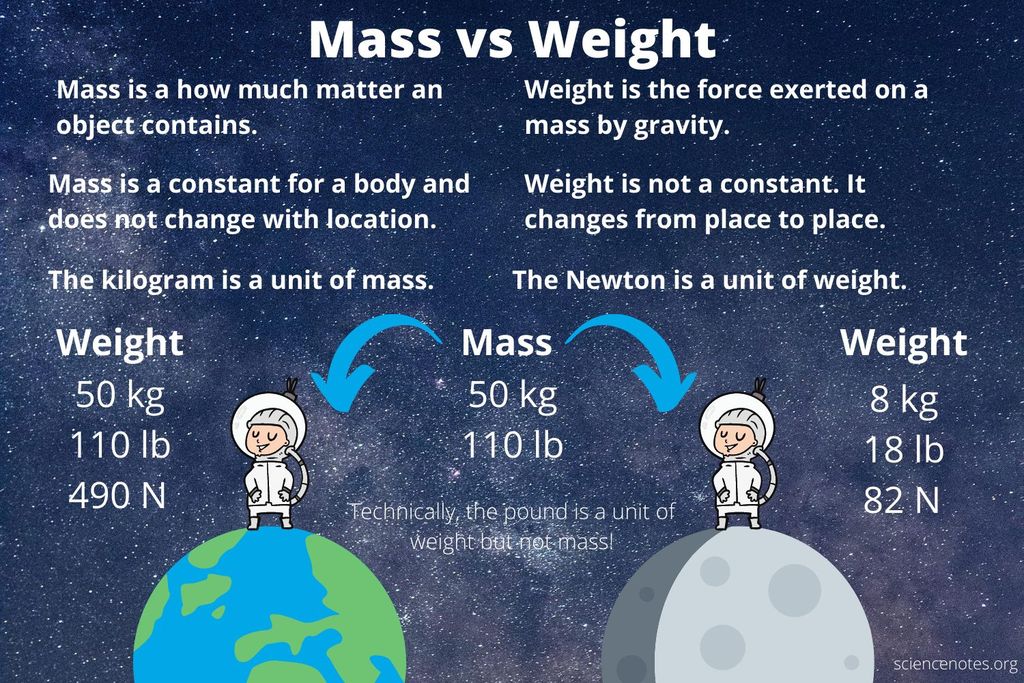
Weight of an Object on the Surface of Moon
Mass of an object is same on earth as well as on moon. But weight is different.
weight of the object on the moon = (1/6) × its weight on the earth.

 Science Made Easy
Science Made Easy
